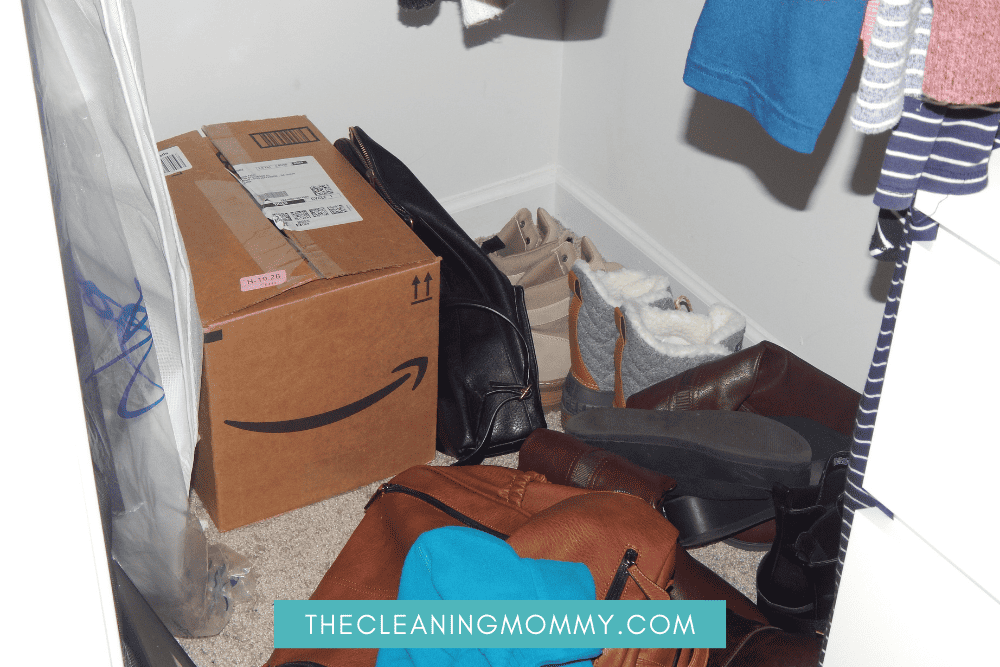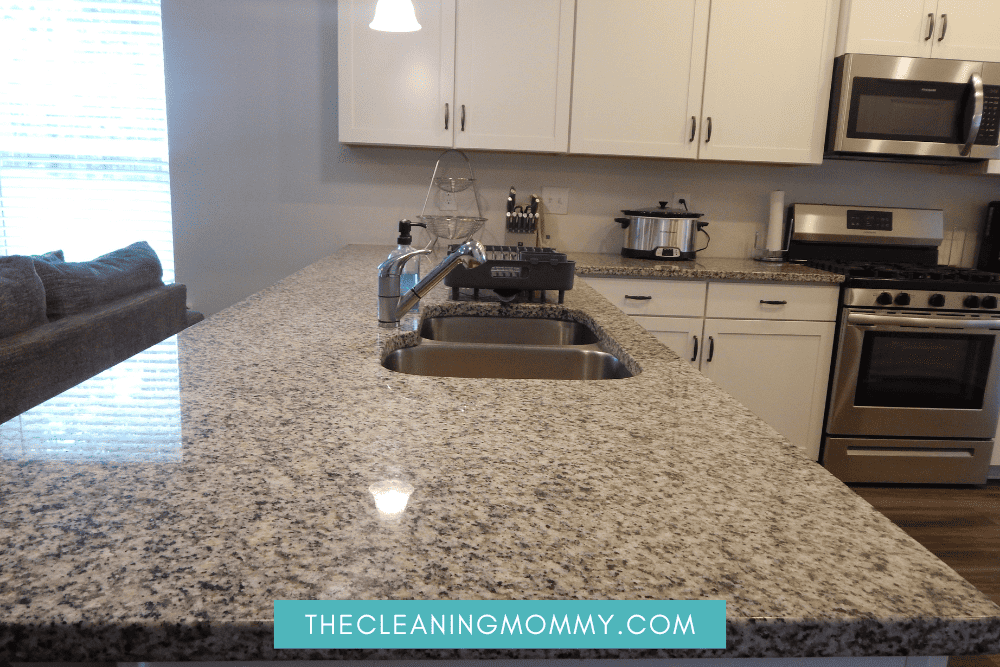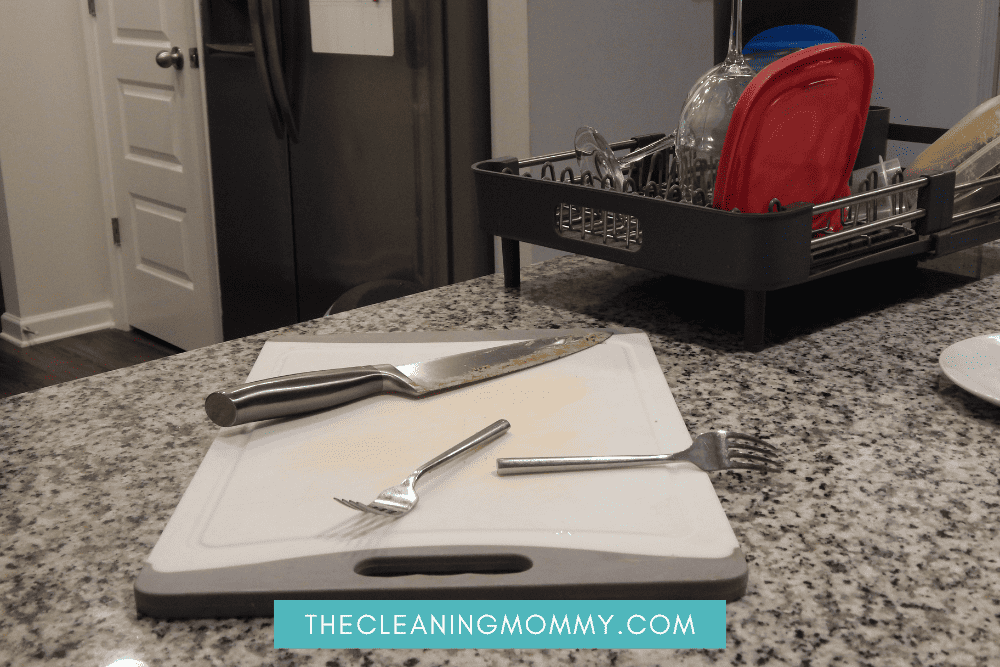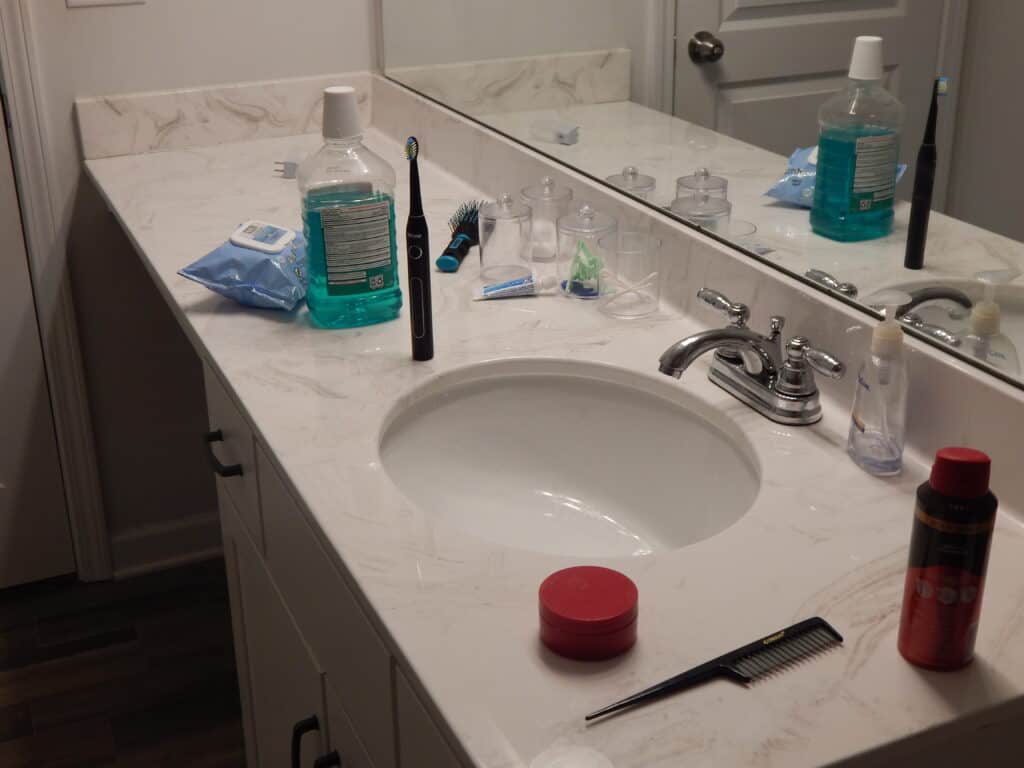Transforming your home into a clutter-free haven can bring immense satisfaction and freedom. However, it can pose challenges when your spouse isn’t fully on board, and doesn’t want to declutter with you!
So, today I am going to share my best strategies for how to declutter when your spouse doesn’t want to!
Decluttering is hard enough to do, but it becomes much harder to declutter when your spouse doesn’t want to!
So how can you get your spouse on board?
Understanding that everyone has different perspectives on clutter is crucial.
You make be at the stage where you have realized that you have too much stuff, and now you want to get rid of it!
But your spouse isn’t there yet!
To make decluttering a positive and collaborative experience for both of you, approach the situation with empathy and open communication.
By sharing your thoughts and feelings and listening to your spouse’s perspective on decluttering, you can create a harmonious atmosphere.
Working together as a team and having an honest conversation with your spouse, will result in a well-maintained, clutter-free home that you both can enjoy.
How to Declutter When Your Spouse Doesn’t Want to!
Don’t let clutter strain your relationship. Discover my top 17 effective strategies to a simpler life and learn how to declutter when your spouse doesn’t want to declutter.
- Approach decluttering as a collaborative effort with your spouse.
- Establish open and honest communication to gain understanding and support.
- Work together to create a positive atmosphere and maintain a clutter-free home.
*This post contains affiliate links. Full disclosure here.

#1 Establishing Open and Honest Communication
To help declutter your home without causing conflict, focus on effective communication and agree on certain ground rules.
Your partner may not understand why you want to declutter, so it’s essential to communicate your reasons.
Explain how decluttering can create more space and reduce a lot of stress in your life and in theirs.
Also, let them know that decluttering can lead to a more organized and functional home.
Communication with your partner is key to getting on the same page.
Be open and honest about your concerns, let them know exactly where you are coming from.
For example, if you are the one that cleans your house, let them know you feel it will be easier to keep on top of things if there was less stuff.
One of the benefits of that happening is less time being spent cleaning and more time to hang out together and do all the fun things you both enjoy.
Tell them you are becoming overwhelmed with too much stuff in the house and you are all about simplifying life!
Be really open and honest with your concerns, but also let them talk, and be sure to listen to their point of view.
This is a time where you need to show a lot of respect for your spouse.
By hearing and understanding each other’s perspective, you will be able to find common ground, and create a shared vision for a clutter free space.
Acknowledge that anxiety may arise during the process and reassure your spouse that you’re on their side in this journey towards a more organized home.
#2 Share the Many Benefits of a Clutter Free Home
Your husband may not be aware of how having a messy home is affecting your own life.
So when it comes time to talk, be sure that your husband sees the many benefits of having a clean and tidy home for you.
For example, show him your laundry room and tell him why laundry takes longer to do, because you’re spending so much time trying to find stuff under the pile of clothes.
There are so many benefits to having a clutter free home:
- You don’t have a panic attach when a friend calls to say they are dropping by.
- More time for family because you’re spending less time cleaning.
- Tell him that a clean home is so much easier to manage them a cluttered home.
- You’re not wasting time looking for missing items, because everything has a place.
- You save money because you enjoy making dinner on your uncluttered kitchen countertops.
Come up with some key benefits that suit your personal situation with your husband, and hope that he is open to hearing what you have to say.

#3 Don’t Nag on Your Spouse
Constantly nagging your spouse about clutter can strain your relationship, potentially causing resentment and mistrust.
The worst thing you can do in this situation is pressure your spouse or family members to do something they don’t want to do.
Show respect for their thoughts and opinions.
Listen to their reasons why they are uninterested in decluttering.
Sometimes it can just be fear of the unknown.
What do you tend to do when someone is pressuring you? Does it help you to get on board or does it make you want to dig your heels in and do the exact opposite of what they want?
When it comes to sharing your thoughts about decluttering and getting your house in order, do just that.
Share your thoughts and why you want less clutter in your home, but don’t nag your spouse or pressure them.
Instead, you want to try to work together and create a plan that works for both of you, listen to their ideas and thoughts too.
Show respect.
For the most part, decluttering is a process that requires everyone’s patience and cooperation.
Don’t race into this at 50 mph and wonder why your spouse doesn’t want to get on board!
#4 Don’t Declutter Your Spouse’s Stuff
When you start the decluttering process, it’s essential to establish clear boundaries with your spouse.
Ensure that you both respect the individual spaces and items that are off-limits.
This includes personal belongings and sentimental items which may hold special meaning for your spouse.
Even if you know your spouse hasn’t worn certain things in their closet for a least a decade, it;s still not okay for you to decide what items of your spouse’s stuff you want to get rid of.
You need to allow them to take his time to go through his personal items and make that decision.
I don’t think you would appreciate if it they went through your stuff in your closet and decided what could stay or go!
You wouldn’t like it and neither will they!

#5 Compromise
It’s important to understand that not everyone will see the need for decluttering right away. Be patient, and don’t push too hard too fast. Instead, try to find common ground and agree on compromises
If your spouse is still resistant to the idea of decluttering, try to find a compromise. Maybe they’re not ready to part with certain items, but they’re willing to store them somewhere else.
.Allow your partner to keep a sentimental item or two and focus on decluttering items that you both agree are no longer needed.
#6 Lead By Example
Sometimes you need to lead by example. Start by decluttering your own stuff and focus on areas that you do have control over.
Begin with areas and items that are solely yours, like your clothes, shoes, jewelry and books.
Once they see what a difference getting rid of your own things makes, it may motivate them to do the same with their own stuff.
Be careful not to stress over things as you declutter, but have a bit of fun with it. If they see you stressing over stuff, they will inevitably get stressed too.
#7 Start Small
When your spouse is hesitant about decluttering, overwhelming them with a massive cleanup project right off the bat might not get the best results.
Instead, start with small, manageable areas that won’t feel too intimidating.
For example, you could begin with a single drawer, a closet shelf, or a countertop.
Just don’t start with the entire closet or garage, that would overwhelm anyone!
By focusing on smaller spaces, you can gradually build momentum and demonstrate the impact of decluttering without causing stress.

#8 Create Clutter Free Zones
If your spouse doesn’t show any signs on getting on board with the decluttering process, try this instead.
Together, you will both decide which areas of the house are going to remain a clutter free zone. This can be one room or a part of a room, it’s totally up to you.
This is a great compromise when you’re trying to figure out how to declutter when your spouse doesn’t want to.
#9 Decide Who Declutters What
Here are some helpful tips to get you started in the right direction when it comes to decluttering.
If you have thought about getting rid of the declutter in your home, the chances are you are already way ahead of your spouse.
It may seem a bit overwhelming for them, so this is a good time to decide who is going to declutter what.
If you spend a lot of time in the kitchen, it might make more sense for you to declutter this space.
Whereas if your husband spends a lot of time in the garage, he probably doesn’t want you touching his stuff and deciding what to declutter!
When it comes to common areas, you may want to tackle them together or compromise and split up the different areas.
Again, you need to be open and honest with your communication to make this work.
#10 Start With An Easy Space
When you’re both ready to tackle decluttering together, start with an easy space and items that typically hold less emotional attachment.
For example, focus on organizing your home’s common areas and getting rid of items like kitchen utensils, linens, or bathroom products.
Once you have made progress in these less daunting spaces, it will build momentum to work on more challenging areas, like family heirlooms or sentimental items.
My best advice is don’t plan a day where you think you can take this on in one day!
You can see the end result in your hear, bags of clutter waiting to be taken to a donation center, and it only took you 8 hours!
From my personal experience, this will completely overwhelm your husband and have him running for the hills.
To be honest, it will probably overwhelm you too.
Decluttering is not for the faint of heart. Don’t try and do a whole room in one day.

#11 Offer To Help Your Spouse
Sometimes your husband is giving pushback because they are overwhelmed at the idea of decluttering and they really don’t even know where to start.
Or they may have more stuff than you and they are freaked out at the idea of getting rid of stuff!
This is where you need to go slow and simplye ask your husband if he needs some help with this process.
Tell him you completely understand how difficult it can be to decide what to declutter and can you help with this.
This may mean you are the one to hold up t shirts while he decides if he wants to get rid of them or not.
Or you hold the garbage bag for him to dump his tools in, or help him to sort out the clutter into smaller piles.
As long as you show him your support, you will help to make the declutter process a little easier for him.
If he says no, you will have to accept his answer, but maybe ask at another time when he may seem more open to the idea.
#12 Be Patient & Encourage Your Husband
Remember that change takes time and patience. It may take more time to get your spouse on board with decluttering, and that’s okay.
Don’t push too hard or get into any confrontations.
Instead, show respect for the effort they are making, and accept that it is going to take them longer to declutter than it will probably take you.
Encourage your husband and start with small steps.
If you’ve tried multiple strategies and your spouse doesn’t want to declutter, then you should maybe accept that you need to consider seeking the help of a professional organizer who can help facilitate the process.

#13 Allocate Them Their Own Space
If your spouse’s stuff is taking over the house, consider giving him a room in your home that is his alone to keep his stuff in.
Maybe your husband is a huge sports memorabilia fan and he has too much stuff that is taking over your house.
Or he has a lot of sentimental items that he wants to keep. Give him his own space where he can keep his own stuff. Let him decorate it anyway he wants and agree that he will keep his stuff (or some may say clutter) limited to this room.
Make sure to agree on certain ground rules such as his clutter must stay within his room and not make its way into other areas of your home.
You must accept that he is in charge of his own clutter and you will not get involved in your husband’s clutter no matter what!
#14 Keep a Maybe Box
This tip is for the spouse who needs to keep everything “just in case”
You know that your husband doesn’t need as much stuff as he seems to think he does.
Bu, you’re having a hard time convincing him of this!!!!!
Try using a ‘maybe box’.
This can work for you also if there are certain items that you are unsure about getting rid of from your life.
Here is what I am talking about, you’re having the declutter talk with your husband, and you can tell he is not totally onboard.
He is worried about getting rid of certain items “just in case” he needs them in the future!
He doesn’t like wasting money buying new items after throwing something away!
Talk him through how he can put certain things he is unsure about getting rid of into a ‘maybe’ box.
Now, put this box away somewhere in your garage or the attic and set a timer on your phone to check back in with the box in 3 or 6 month’s time.
If you haven’t needed what’s in the box in that timeframe, you should be feeling much more cofident about getting rid of the items in the box.
This will certainly get your spouse rethinking getting rid of certain items.
I would recommend making the timeframe shorter rather than longer. You don’t want to set a timer for 1 year later.

#15 Ask For His Input
If your husband or spouse isn’t totally against the idea of decluttering, get them involved!
Sometimes, your spouse simply doesn’t want to do all the hard work that can be involved with decluttering.
When it comes to getting rid of stuff, ask for their opinion. Place any items you are thinking of getting rid of in front of them, and ask for their opinion.
Things might work two ways.
One, they may see how much hard work is involved and they may change their mind and get involved.
Or, they will at least feel like they are somewhat involved in the whole process and that their opinion matters.
Having a little talk about which item to get rid of and hearing what they have to say, can sometimes help you to find the answer you are looking for.
#16 Follow This Rule
When it comes to decluttering, there are certain ground rules you and your husband should abide by.
My husband and I are pretty good when it comes to living with less stuff because we want a simpler life.
We lived in a 30′ RV for over 5 years, so we’re good with the less clutter!
However, I now have a daughter who will keep anything and everything!
She has a messy cluttered room and so I have had to set some ground rules for her
For any new stuff she brings in, the same number of items need to go!
The hubby and I do this from time to time.
I love shopping for deals at Hobby Lobby for seasonal decor, and even though the items are on sale, I still spend a lot of money!
Implementing this rule has helped us to stop buying stuff we really don’t need.
Sticking to this rule has made a huge impression in my own life and has saved us a ton of money.
Most people that follow this rule, don’t live in a messy home.

#17 Make Decluttering Fun
You have much more of a chance to get your husband on board if you make decluttering a fun time.
Planning an entire day to declutter is hard work and is a bit of a crazy idea to be honest.
To avoid feeling overwhelmed and keep the process enjoyable, try setting a timer for short decluttering sessions.
You can work together for 15-30 minutes and then take a break to watch your favorite tv show, or enjoy a yummy treat.
It’s important to reward yourselves with something fun. Doing this can help the decluitter process feel less overwhelming and make it much more enjoyable for both of you.
So set a timer for a specific time frame and when it goes off, no matter what, decluttering is done for the day!
You could also try doing this.
If you are competitive with your spouse, you could create a challenge. See who can fill 2 bags of all the things you no longer need, or who can declutter more items in a certain timeframe.
The winner has dinner made for them, or breakfast in bed!
Final Thoughts on How to Declutter When Your Spouse Doesn’t Want To!
Following a few key steps will make it easier for you and your spouse to maintain a clutter-free home, even if one spouse is reluctant to declutter.
Take some time each month to check on your own stuff and your spouse’s stuff to make sure things aren’t getting out of control again.
These are my best tips for how to declutter when your spouse doesn’t want to.
I truly hope that If you follow the strategies above, you will still be able to maintain a clutter free home.
Set some ground rules, be open and honest with each other (in a caring way), and encourage each other.
It may take some time, but you’ll eventually get your spouse somewhat on board, even if they don’t jump on board fully.
Always remember, your relationship si much more important thatn having a perfectly clean home. So, if your spouse always seems to have a diy project on the go, let him enjoy it, just maybe see if he can heep it in the garage!
Have you ever had issues with trying to declutter when your spouse doesn’t want to?
Other Cleaning Articles You May Like:
- How to start decluttering when you are completely overwhelmed
- Things to declutter
- How to declutter your room
- Decluttering tips for hoarders
- Checklist to help declutter your home
- Quotes about decluttering

Grainne Foley
Grainne Foley is a wife and mother of 2 great kids. During her 5 years of full time RV travel, Grainne learned to become very efficient at household chores, in order to make time for family adventures. Now, back in a house, she has continued to create tools and techniques to help others lighten the load of household organization and cleaning.




Leave a Reply